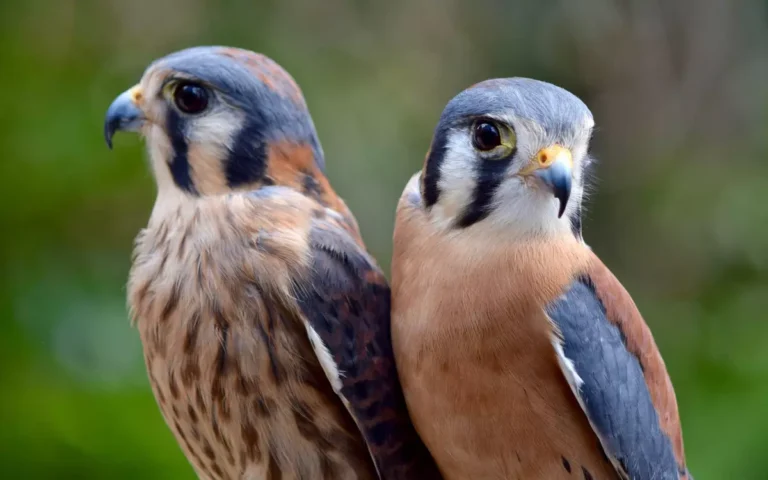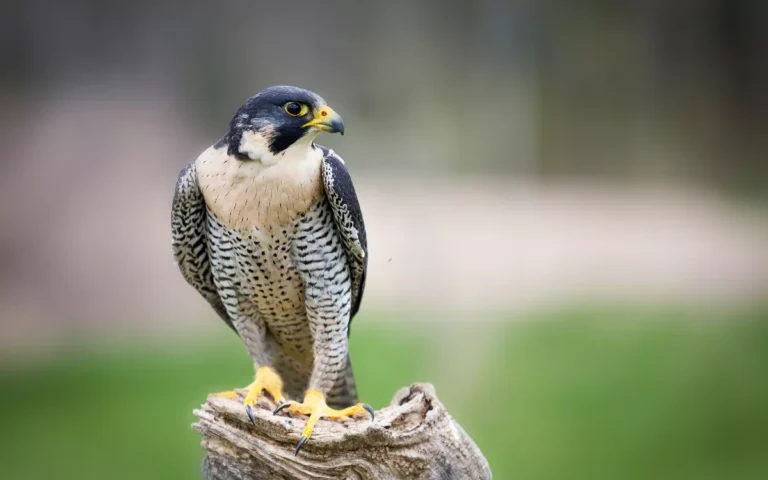9 Blue Colored Birds To See

In Colorado, we find many blue-colored birds that are beautiful to observe, from the Mountain Bluebird to the Tree Swallow. So, let’s dive into examining these beautiful birds.
Common Blue Bird Species in Colorado:
1. Mountain Bluebird (Sialia currucoides)
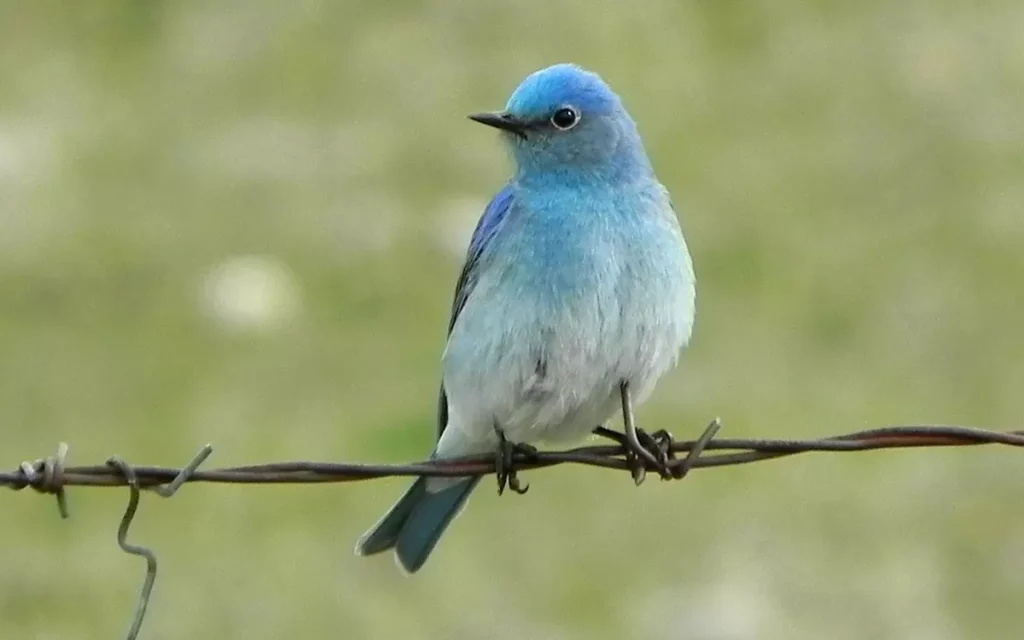
- Kingdom: Animalia
- Phylum: Chordata
- Class: Aves
- Order: Passeriformes
- Family: Turdidae
- Genus: Sialia
- Species: S. currucoides
The Mountain Bluebird lives in open fields and mountains. Its bright blue color makes it easy to spot. Males are more vibrant than females, who are mostly grayish-blue.They migrate south when it gets cold, returning in spring for breeding.
During migration, they may travel as far as central Mexico from their northern homes.These birds love areas cleared by fires or logging because it’s easier for them to find their main food, insects. In winter, they might also eat berries. They nest in holes in trees or birdhouses put up by people.
- Length: 6.1-7.1 in (15.5-18 cm)
- Weight: 0.85-1.31 oz(24-37 g)
- Wingspan: 11.0-14.2 in (28-36 cm)
2. Western Bluebird (Sialia mexicana)
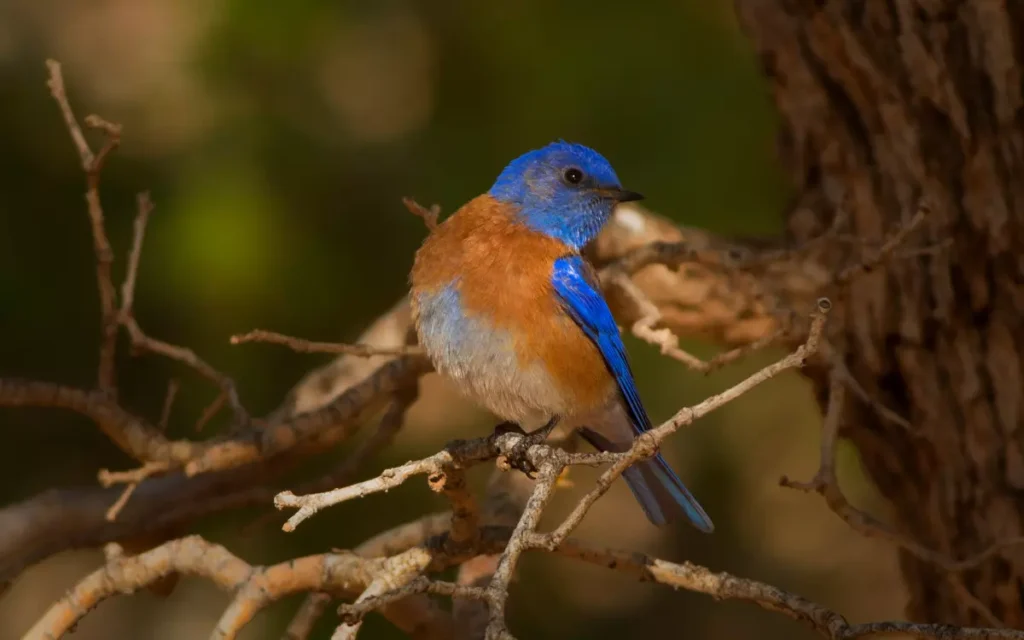
- Kingdom: Animalia
- Phylum: Chordata
- Class: Aves
- Order: Passeriformes
- Family: Turdidae
- Genus: Sialia
- Species: S. mexicana
The Western Bluebird is a small bird with bright blue feathers and orange on its chest and sides. It lives in open woodlands and parks in western North America.These birds eat mostly insects and berries, which they find while hopping on the ground.
They nest in holes in trees or nest boxes, where they lay four to six eggs once or twice a year.The Western Bluebird has a lifespan of about 6 to 7 years in the wild. They are important for the environment because they help control insect populations.
- Length: 6.3-7.5 in (16-19 cm)
- Weight: 0.8-1.1 oz (24-31 g)
- Wingspan: 11.8-13 in (30-33 cm)
3. Steller’s Jay (Cyanocitta stelleri)
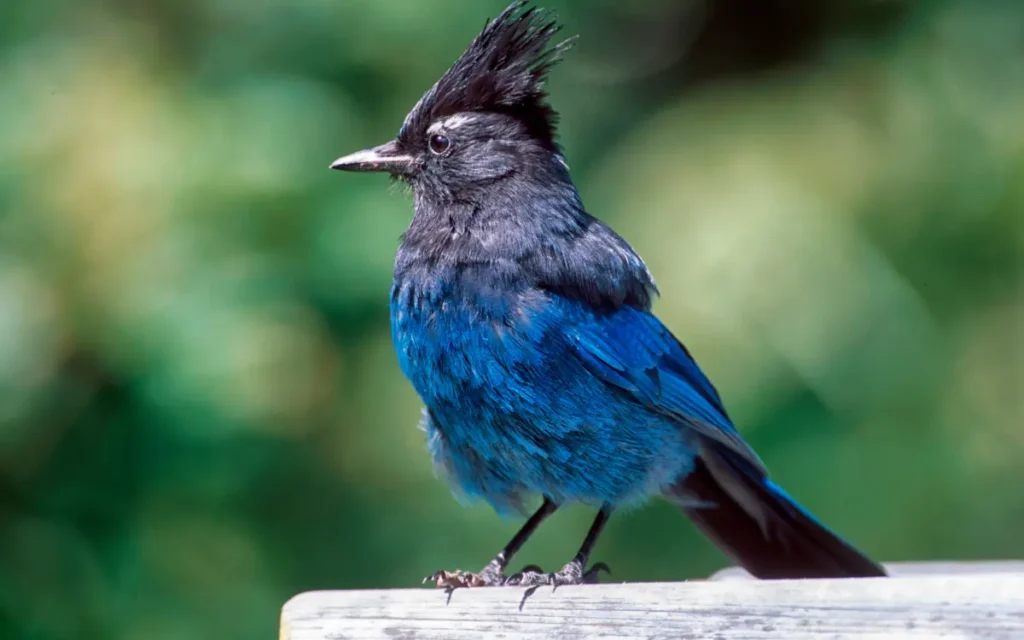
- Kingdom: Animalia
- Phylum: Chordata
- Class: Aves
- Order: Passeriformes
- Family: Corvidae
- Genus: Cyanocitta
- Species: C. stelleri
The Steller’s Jay is a vibrant bird with blue and black feathers and a noticeable crest on its head. It lives in western North America’s forests. This clever bird eats insects and seeds and can mimic other birds’ calls.
They build their nests in trees and lay about 3 to 5 eggs each year. The average lifespan of a Steller’s Jay in the wild is around 16 years, making them a familiar sight both in deep forests and suburban areas where they interact with humans.
- Length: 11.8-13.4 in (30-34 cm)
- Weight: 3.5-4.9 oz (100-140 g)
- Wingspan: around 17.3 in (44 cm)
4.Blue Jay (Cyanocitta cristata)
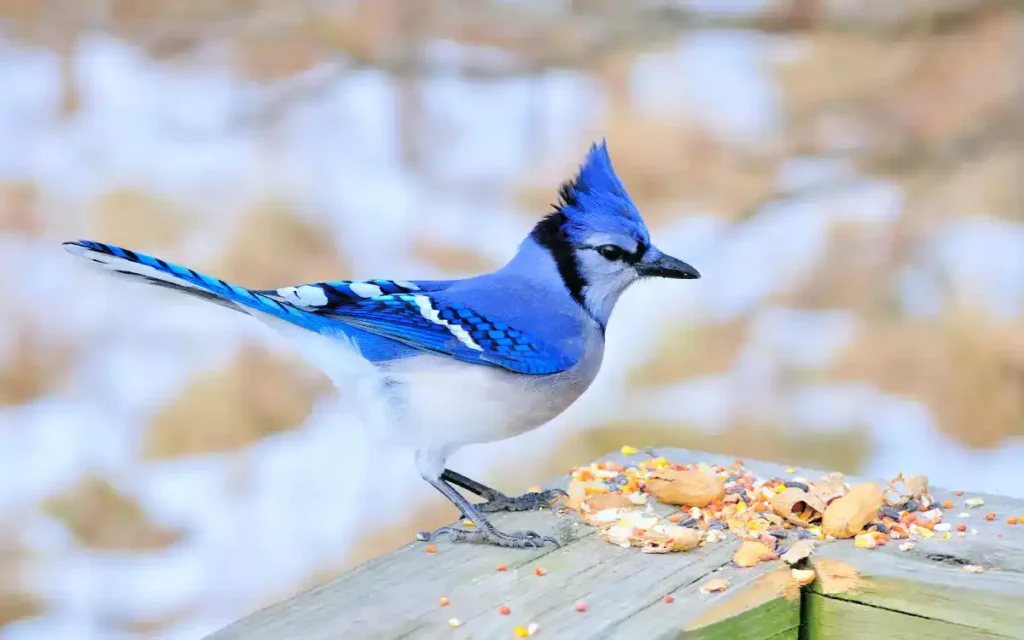
- Kingdom: Animalia
- Phylum: Chordata
- Class: Aves
- Order: Passeriformes
- Family: Corvidae
- Genus: Cyanocitta
- Species: C. cristata
The Blue Jay is a colorful bird with bright blue feathers on its back and tail, and a white face and belly. They are known for their loud calls and are common in wooded areas in eastern North America.
Blue Jays eat seeds, nuts, and insects, and are famous for their love of acorns. They build nests in trees and typically lay 4 to 5 eggs once a year. The average lifespan of a Blue Jay in the wild is around 7 years, but they can live longer in captivity.
- Length: 9.8-11.8 in (25-30 cm)
- Weight: 2.5-3.5 oz (70-100 g)
- Wingspan: 13.4-16.9 in (34-43 cm)
Lesser-Known Blue Birds:
5.Blue Grosbeak (Passerina caerulea)

- Kingdom: Animalia
- Phylum: Chordata
- Class: Aves
- Order: Passeriformes
- Family: Cardinalidae
- Genus: Passerina
- Species: P. caerulea
The Blue Grosbeak is striking with its deep blue feathers and distinctive rusty wing bars. This bird prefers living in open wooded areas across the southern United States. It primarily feeds on insects, seeds, and grains.
The Blue Grosbeak builds its nest in dense shrubs or small trees and usually lays 3 to 5 eggs each breeding season. The lifespan of these birds in the wild is typically around 6 to 7 years. Known for their robust size compared to other grosbeaks, they are a vibrant sight during the breeding season.
- Length: 5.9-6.3 in (15-16 cm)
- Weight: 0.9-1.1 oz (26-31 g)
- Wingspan: 11.0 in (28 cm)
6.Indigo Bunting (Passerina cyanea)

- Kingdom: Animalia
- Phylum: Chordata
- Class: Aves
- Order: Passeriformes
- Family: Cardinalidae
- Genus: Passerina
- Species: P. cyanea
The Indigo Bunting is known for its brilliant blue color, with males displaying a striking all-blue body and females having a brownish tone. They thrive in brushy forest edges and open areas across eastern North America. These buntings primarily eat insects and seeds.
They build their nests close to the ground in dense bushes, typically laying 3 to 4 eggs each breeding season. The lifespan of an Indigo Bunting in the wild is about 10 years. Their bright plumage and cheerful songs make them a favorite among birdwatchers during the summer months.
- Length: 4.5-5.9 in (11.5-15 cm)
- Weight: around 0.51 oz (14.5 g)
- Wingspan: 7.1-9.1 in (18-23 cm)
Read also: 15 common Yellow Birds Colorado with (ID & images)
7.Lazuli Bunting (Passerina amoena)

- Kingdom: Animalia
- Phylum: Chordata
- Class: Aves
- Order: Passeriformes
- Family: Cardinalidae
- Genus: Passerina
- Species: P. amoena
The Lazuli Bunting is a small bird with a bright blue head and cinnamon breast in males, while females are mostly brown. They live across the western United States, often found in brushy areas and open woodlands.
Their diet consists mainly of seeds and insects. Lazuli Buntings typically build their nests in dense shrubs, laying 3 to 4 eggs per breeding season. The lifespan of these birds in the wild is around 5 years. Their colorful appearance and sweet songs make them a delightful sight during the spring and summer.
- Length: 5.1-5.9 in(13-15 cm)
- Weight: 0.5-0.6 oz (13-18 g)
- Wingspan: 8.7 in (22 cm)
Unique and Rare Blue Birds:
8.Belted Kingfisher (Megaceryle alcyon)

- Kingdom: Animalia
- Phylum: Chordata
- Class: Aves
- Order: Coraciiformes
- Family: Alcedinidae
- Genus: Megaceryle
- Species: M. alcyon
The Belted Kingfisher is known for its striking blue-gray plumage and large head with a shaggy crest. Males have a single blue band across their white chest, while females feature a blue and chestnut band. They are commonly found along rivers, lakes, and coasts throughout North America.
Their diet mainly consists of fish, which they catch by diving from perches above water. They nest by burrowing tunnels in riverbanks, and typically lay 5 to 8 eggs per year. The lifespan of Belted Kingfishers in the wild is about 6 to 14 years, making them a long-lived bird species for their size.
- Length: 11-14 in (28-36 cm)
- Weight: 4.0-6.3 oz (113-179 g)
- Wingspan: 19-23 in (48-58 cm)
9. Tree Swallow (Tachycineta bicolor)

- Kingdom: Animalia
- Phylum: Chordata
- Class: Aves
- Order: Passeriformes
- Family: Hirundinidae
- Genus: Tachycineta
- Species: T. bicolor
The Tree Swallow is a sleek bird with shiny blue-green upperparts and white underparts. They are found across North America, thriving near open water and fields where they can easily find insects, their main food source. These birds are agile fliers, often seen swooping over water and fields catching insects mid-air.
They nest in tree cavities or bird boxes, laying 4 to 6 eggs each season. The lifespan of Tree Swallows in the wild ranges from 4 to 8 years. Their quick flight and iridescent colors make them a delightful sight during their breeding season.
- Length: 4.7-5.5 in(12-14 cm)
- Weight: 0.60-0.90 oz (17-25.5 g)
- Wingspan: 12-14 in(30-35 cm)
Habitat and Conservation:
Unfortunately, their homes are at risk due to human activities like building and pollution. Conservation efforts are crucial to protect these birds. Programs that create safe areas for them to live and breed help maintain their populations and ensure that we can enjoy their beauty for a long time.
bird watching place and tips in Colorado:
In Colorado, great spots for watching bluebirds include Rocky Mountain National Park and the San Juan National Forest. To spot birds like the Mountain Bluebird or the Tree Swallow, bring binoculars and visit during the early morning or late afternoon when birds are most active.
Remember to be quiet and keep a distance to not disturb them. While looking for these blue beauties, you might also come across Black Birds Colorado, adding variety to your birdwatching adventure.
FAQs:
Which bird’s color is blue?
Birds like the Mountain Bluebird, Western Bluebird, and Indigo Bunting are primarily blue.
What is the rarest bird in Colorado?
The Brown-capped Rosy Finch is considered one of the rarer birds in Colorado, primarily found in the high alpine areas of the Rocky Mountains.
What is the most common bird in Colorado?
The American Robin is one of the most common birds found throughout Colorado.
What is the official bird of Colorado?
The Lark Bunting is the official state bird of Colorado.
What bird disease is in Colorado?
Avian influenza, also known as bird flu, has been detected in Colorado.
What is the rarest animal in Colorado?
The black-footed ferret is one of the rarest animals in Colorado, once thought to be globally extinct.
Conclusion:
Blue birds add vibrant colors and life to Colorado’s landscapes, making birdwatching a joyous activity. They are vital for maintaining the health of local ecosystems. Let’s keep supporting and learning about wildlife conservation to help these beautiful birds thrive in their natural habitats.

